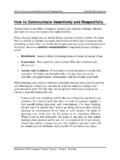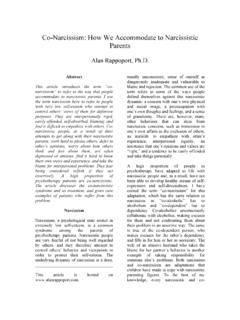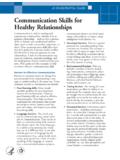Transcription of MRT Skills Overview - 9Line LLC
1 MRT Skills OverviewMRT Competencies: Self-awareness Self-regulation Optimism Mental Agility Strengths of Character Connection ATCI dentify your Thoughts about an Activating Event and the Consequences of those the A(Activating Event) from your T(Thoughts) from the C(Consequences: Emotions and Reactions) in order to understand your reactions to a Thinking TrapsIdentify and correct counterproductive patterns in thinking through the use of Critical Questions. Use the Critical Questions to identify information you missed because of the Thinking Trap.
2 Jumping to Conclusions: Slow Down: What is the evidence? Mind Reading: Speak up: Did I express myself? Did I ask for information? Me, Me, Me: Look outward: How did others and/or circumstances contribute? Them, Them, Them: Look inward: How did I contribute? Always, Always, Always: Grab control: What s changeable? What can I control? Everything, Everything, Everything: Look at behavior: What is the specific behavior that explains the situation? Detect IcebergsUse the What questions in any order to help identify the Iceberg Belief:ThoughtsEmotions/ReactionsLoss (I have lost something)Sadness/WithdrawalDanger (Something bad is going to happen and I can t handle it)Anxiety/AgitationTrespass(I have been harmed)Anger/AggressionInflicting harm (I have caused harm)Guilt/ApologizingNegative comparison (I don t measure up)Embarrassment/HidingPositive contribution (I contributed in a positive way)Pride/Sharing, planning future achievementsAppreciating what you have received (I have received a gift that I value)
3 Gratitude/Giving thanks, paying forwardPositive future (Things can change for the better)Hope/Energizing, taking action1 Detect IcebergsIdentify deep beliefs and core values that fuel out-of-proportion emotion and evaluate the accuracy and usefulness of these the What questions in any order to help identify the Iceberg Belief: Whatis the most upsetting part of that for me? Whatdoes that mean to me? Whatis the worst part of that for me? Assuming that is true, whatabout that is so upsetting to me?One you ve identified your Iceberg, ask yourself:Is this Iceberg helping or harming me in this situation?
4 Is this Iceberg something I still believe/value? Is this Iceberg accurate in this situation?Energy ManagementRegulate emotion and energy levels to enable critical thinking and optimal strategies to regulate emotion and to think clearly and respond with control: Mental Games Controlled Breathing Progressive Muscle Relaxation Meditation Positive ImageryProblem SolvingAccurately identify what caused the problem and identify solution your thoughts about why the problem happened, identify other factors with Critical Questions, test them for accuracy, and then identify solution strategies: Step 1:What s the problem?
5 Step 2:What caused the problem? Step 3:What did you miss? Step 4:What s the evidence? Step 5:What really caused the problem? Step 6:What can you do about it?Fight the Confirmation Bias:Distance yourself from your thought, ask fair questions, consult with others, and prove your thoughts It In PerspectiveStop catastrophic thinking, reduce anxiety, and improve problem solving by identifying the Worst, Best, and Most Likely outcomes of a the Worst, Best, and Most Likely outcomes of a situation in that order and develop a plan for dealing with the Most Likely outcomes: Step 1:List worst case outcomes and ask, And then what happens?
6 Step 2:List best case outcomes and ask, And then what happens? Step 3:List most likely outcomes. Step 4:Identify plan for dealing with most 2010 by The Trustees of the University of Pennsylvania. All rights reserved. This is a n ew sq uad an d my S ol diers h av e a lo t to lea Smith is h aving a rou gh trans itio n. *I hav en't spe nt mu ch time o n team bu il d in g. *I som etimes rush th ro ugh my d escrip tio n o f th e o bj ec tiv e and do n t com mun icate cl early. *M y s qu ad d oes n' t h ave wh at i t takes.
7 MRT Skills OverviewReal-time ResilienceShut down counterproductive thinking to enable greater concentration and focus on the task at back against counterproductive thoughts by using the sentence starters: That s not completely true (evidence) A more optimistic way of seeing this (optimism) The most likely implication I (perspective) Avoid the common pitfalls: Dismissing the grain of truth, minimizing the situation, rationalizing or excusing one s contribution to a problemIdentify Strengths in Self and OthersIdentify strengths in yourself and in others to build on the best of yourself and the best of your top Character Strengths and those of others and identify ways to use your strengths to increase your effectiveness and strengthen your relationships.
8 VIA Character Strengths:Appreciation of beauty and excellence Bravery Capacity to love Caution, prudence Citizenship, teamwork Creativity Curiosity Fairness Forgiveness Gratitude Honesty Hope Humor Industry, perseverance Judgment, critical thinking Kindness Leadership Love of learning Modesty Perspective Self-control Social intelligence Spirituality, sense of purpose ZestUse Strengths in ChallengesIdentify strengths in yourself and in others to improve teamwork and overcome the specific actions that flow from your strengths in challenges and in successes: Step 1:Name the strength that you used or will use.
9 Step 2: How did you or will you use that strength to deal with the challenge? Step 3: Draw on strengths of team members for complex CommunicationCommunicate clearly and with respect, especially during a conflict or challenge. Use the IDEAL model to communicate in a Confident, Clear, and Controlled the IDEAL Model to communicate assertively: I= Identify and understand the problem D= Describe the problem objectively E = Express your concerns and how you feel A= Ask the other person for his/her perspective and ask for a reasonable change L= List the consequencesActive Constructive Responding and PraiseRespond to others with authentic, active and constructive interest to build strong relationships.
10 Praise to build mastery and winning Constructive Responding is authentic, constructive interest. It helps the other person to savor their positive experience and leaves them feeling validated and understood. Create winning streaks by using Praise to name strategies, processes, or behaviors that led to the good the Good StuffHunt the Good Stuff to counter the negativity bias, to create positive emotion, and to notice and analyze what is three good things each day and write a reflection next to each positive event about: Why this good thing happened What this good thing means to you What you can do tomorrow to enable more of this good thing What ways you or others contribute to this good thingCopyright 2010 by The Trustees of the University of Pennsylvania.








